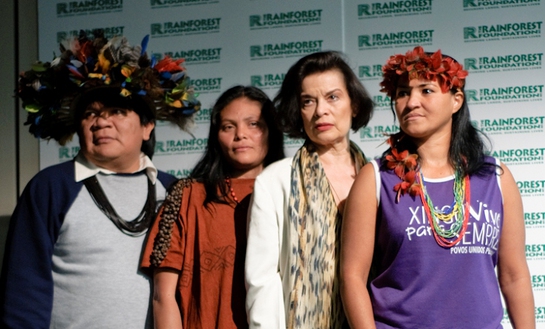Three Amazon indigenous leaders have travelled to London to rally public, press and government support of their communities’ fight against socially and environmentally destructive mega-dams planned for the Amazon basin – gaining the support of Sting and Bianca Jagger.
Chief Almir Narayamoga Surui, leader of the Suruí tribe of the Madeira River Basin, Brazil; Ruth Buendia Mestoquiari, President of Central Asháninka of the Ene River, Peru; and Sheyla Yakarepi Juruna, representative of the Juruna tribe of the Xingu River Basin, Brazil, have travelled to Olso, Geneva, Paris and now finally London to highlight the violation of indigenous peoples’ rights their peoples are facing with the planned construction of these Amazon mega-dams that will destroy enormous areas of rainforest and displace thousands of forest-dwelling peoples. The indigenous leaders are here with the support of the Rainforest Foundation UK, in conjunction with other NGOs Amazon Watch and International Rivers, with financial support from Rainforest Concern.

Credit/Copyright: Rainforest Foundation UK
Chief Almir Narayamoga Surui, leader of the Suruí tribe of the Madeira River Basin, Brazil; Ruth Buendia Mestoquiari, President of Central Asháninka of the Ene River, Peru; and Sheyla Yakarepi Juruna, representative of the Juruna tribe of the Xingu River Basin, Brazil, (pictured L-R from today’s press conference with Bianca Jagger)
“In its voracious appetite for energy, and facing concerted opposition at home for its plans to dam rivers in the Amazon Basin, Brazil is now looking to colonise parts of neighbouring countries for energy production,” says Sting. “This does not solve the environmental problems caused by large dams in rainforests nor reduce the impacts on indigenous people – it merely exports them. Peru’s Asháninka people have been granted the legal rights to their land in the Peruvian Amazon, and this should not be arbitrarily overturned by a Brazilian company, in defiance of international law on the rights of indigenous peoples.”
The Brazilian Government’s mega-dam plans in the Xingu, Madeira, and Tapajós river basins including the controversial Belo Monte Dam and the Madeira Dam Complex – both in the Brazilian Amazon – and six dam projects including the Pakitzapango Dam in the Peruvian Amazon, threaten many different indigenous and non-indigenous communities, many of which have been living in these forests for thousands of years. The delegation is hoping to ensure respect for the rights of local populations whose livelihoods depend on these riverine ecosystems, while highlighting alternatives to these projects for meeting Brazil’s and Peru’s energy needs.
The delegation hopes to encourage European governments to utilise their abilities to influence Brazilian energy policy, but also to place pressure on the European stakeholders and the main financier of these projects – the Brazilian National Development Bank (BNDES) – to refrain or withdraw their support.
Ruth Buendia Mestoquiari, President of Central Asháninka Del Rio Ene, Peru said: “The Brazilian Government is exporting a false development model to my people by pressuring the Peruvian Government to build dams on our lands and using its development bank and its companies to implement these projects that will only bring more poverty, not development. The Brazilian Development Bank is financing projects that are deeply affecting the peace of my community in the central Peruvian jungle. They are not worried that these projects will force my people from their land and end our way of life.”
The three dam projects are as follows:
PAKITZAPANGO HYDROELECTRIC DAM
The Pakitzapango hydroelectric dam – named after the narrow gorge that for the Asháninka is the mythological birthplace of the Amazonian tribes – is the latest and the largest threat to the Asháninka communities. At 165m high, its floodwaters will cover almost 100,000 hectares, and affect more than 10,000 Asháninka people in the Ene River Valley. These people will lose their homes, farms and lands under the new dam’s floodwaters in only a few years’ time.
The Peruvian Government has entered into a huge agreement with the Government of Brazil to build a series of hydroelectric dams, and the electricity will be exported to help power Brazil’s burgeoning urban centres. The centre piece of the project is Pakitzapango dam, but at least five more dams will follow on other rivers in the region. The construction of this dam, and associated projects in the pipeline, represent major investment opportunities for private companies and for the Brazilian and other multilateral banks. Brazilian companies Electrobras, Odebrecht, Engevix, Camargo Correa, Andrade Gutierrez, and the Brazilian National Development Bank (BNDES) are driving the push to build these dams.
In essence, the memorandum between the two Governments will allow Brazil to study, finance, build and operate up to six very large hydroelectric power plants on Peruvian soil to supply its energy requirements by purchasing a large part of the energy produced in Peru. The hydroelectric plants chosen by Brazil are Inambari (2,000 MW), Sumabeni (1,074 MW), Urubamba (940 MW), Vizcatan (750 MW), Chuquipampa (800 MW),and Pakitzapango (2,000 MW), and as well as the corresponding transmission lines which will be integrated into the Brazilian system. The total cost of these six undertakings will amount to the order of US$16 billion. Pakitzapango is the second project selected on the Ene River at the confluence of Satipo and Junín Departments, and will cost approximately US$6 billion. This concession was granted without informing or consulting the Asháninka communities, demonstrating the Peruvian Government’s lack of respect for the Asháninka way of life, and more fundamentally, for their human rights as enshrined in national and international law.
“The Pakitzapango hydroelectric dam will devastate human lives and biodiversity by submerging and therefore destroying thousands of acres of forests and agricultural land,” says Bianca Jagger. “It is deplorable that the Asháninka people should have to implore and appeal to the better nature of their Government, who have an obligation to protect their human rights and habitat, but who instead continue to violate these fundamental rights. They must be held accountable.”
MADEIRA RIVER COMPLEX
The Madeira River Complex — an enormous mega-project including the construction of four hydroelectric dams, extensive river dredging and opening of channels — is currently underway in Brazil’s western Amazon. The Madeira River Complex is part of two larger initiatives: the Integrated Regional Infrastructure for South America (IIRSA) – an effort by the national governments to construct a new infrastructure network for the region – and the Accelerated Growth Program (PAC) – the flagship ‘development’ programme of Brazil’s President Lula.
Despite being heavily promoted as a necessary hydroelectric project for Brazil to meet its increasing energy demand, the underlying justification for the Madeira River Complex is that it will serve to promote raw material export, particularly soybeans, timber and minerals. Through the installation of navigation locks and dredging to open the river channel, the Madeira River Complex will connect the western part of Brazil with highways being built in the Peruvian and Bolivian Amazon to the Pacific, facilitating the export of raw materials to Asia and North America.
Already under construction, the Santo Antônio and Jirau dams are causing negative impacts on the region’s ecosystems and local populations, including indigenous peoples in voluntary isolation. Effects include the permanent displacement of families and communities, the potential extinction of migratory fish species on which local communities depend, the increased spread of malaria, increased erosion of riverbanks, the loss of access to agriculture and forest extractive products, and stronger pressure on already lacking social services due to the migration of families in search of jobs. The contingent of people looking for work who have flooded into the region is far greater than the number of jobs created by the dam construction, overstretching the state capital Porto Velho and contributing to problems commonly associated with the overpopulation of urban centres, such as violent crime.
BNDES has approved R$7.2 billion in financing to build the Jirau dam, while the Santo Antônio dam will receive R$6.1 billion. Without BNDES financing, the Madeira Complex would not be built, as the risks and enormous costs of the project would not attract sufficient investment from private institutions.
BELO MONTE DAM
The Brazilian Government is planning to build what would be the world’s third largest hydroelectric project on one of the Amazon’s major tributaries, the Xingu. The project would divert nearly the entire flow of the Xingu River along a 62-mile stretch known as the Big Bend (Volta Grande) leaving indigenous peoples and other traditional inhabitants without fish, clean water and river transportation that are essential for their survival. The sheer enormity of the project means that an area of more than 1,500 square kilometers would be devastated, resulting in the forced displacement of 20,000 –40,000 people, and grave impacts to the land and livelihood of 800 indigenous people and thousands of riverine and urban families. Some 100,000 migrants are expected to arrive in the region in search of jobs, overwhelming already strained public services in health, sanitation and public security and increasing pressures on forests.
Given the seasonal fluctuations of the Xingu River, the 11,000-megawatt Belo Monte dam would only produce an average of 1/3 of its installed capacity. The project will not be economically viable without the construction of additional dams upstream to store water during dry seasons. The upstream dams would mean dire consequences for the well-preserved rainforest and indigenous territories of the upper Xingu. The Belo Monte dam complex is expected to cost upwards of USD $17 billion, including $2.5 billion for the transmission lines. The project has been developed by the state-owned energy company Eletronorte, and would be funded largely by BNDES, which has publicly committed to financing up to 80% of the project cost. Financing for Belo Monte would represent the largest loan in BNDES’s history, for which the bank has offered unprecedented loan conditions, including 30-year interest periods at 4%, significantly below the cost of capital.
“We are here to bring awareness of these serious problems,” said Chief Almir Narayamoga Surui, Leader of the Suruí Tribe of the Madeira River Basin. “We bring our worries and our experience of realities on the ground in our communities, such as what is being done on the Madeira River, building dams that jeopardize the survival of isolated indigenous peoples. The government says it is concerned with green and sustainable development and the protection of human rights, but we see that their practice is quite different. I wonder how the Brazilian government feels; how can they promote projects that could force a people to extinction?”
More information can be found here.





